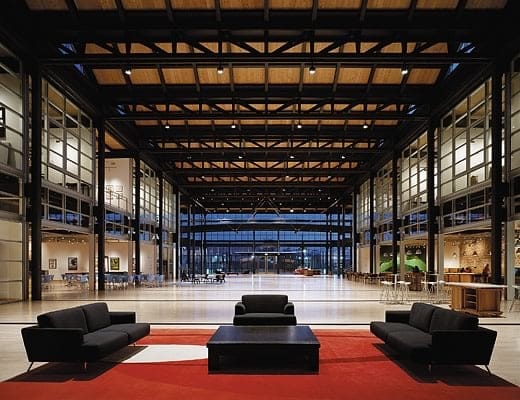Inspiring Collaborative Workspace Design Solutions
Unlock the potential of teamwork with our collaborative office space design services. Whether you're envisioning a shared workspace design or searching for fresh collaborative workspace ideas, we craft environments that foster creativity, communication, and productivity. From sleek, modern layouts to flexible office design ideas tailored for collaborative workspaces, our approach transforms ordinary offices into dynamic, engaging places where teams thrive.
Workplaces are changing. Organisations are moving towards modern collaborative workspaces, where employees can connect, share ideas, and work together. Open designs are replacing traditional isolating cubicle-style offices. But many organisations are yet to perfect this design shift and should consider the benefits of investing in a space solely for collaboration and socialising.
Consider the humble office watercooler. Once a simple break spot, it became an organic shared workspace design for spontaneous conversations where fresh ideas, relationships, and cross-functional projects often began. Fresh ideas, relationships and cross-functional projects grew out of these informal meetings. Studies have shown providing collaborative and social spaces can boost productivity levels in your people by 25 percent.
Thankfully, many organisations are trying to change the way their office works. However, that doesn’t mean organisations are succeeding at encouraging collaboration and brainstorming. It takes more than knocking down a few walls to nurture the cross-pollination of ideas of employees from different disciplines and boost productivity. Employers should look at physically carving out spaces specifically designed for employees to socialise and connect.
Social interactions are more likely to foster collaboration and promote learning. This is for the simple reason that your employees get to know each other. It’s easier for an automation technology employee to get help from the design department if they know who to talk to. Quality relationships improve the sharing of knowledge and expertise within and between teams.
In Gallup’s 2014 State of the Global Workplace, more than 50 percent of employees said they weren’t engaged at work. However, innovative office design ideas for collaborative workspaces can change this. Designs that enable people from different departments to meet, swap ideas, and bring new values into daily life benefit everyone.
The Pixar offices make a great case in point and were the epitome of traditional workspaces. Computer scientists were in one building, animators in a second building, and executives and editors in a third. When Steve Jobs famously decided to include an atrium at Pixar’s campus, he did so with a vision of bringing these siloed groups together into a collaborative space. Segregation had led the groups to form their own cultures and approaches to problem-solving, which discouraged them from sharing ideas and solutions.
So, Jobs introduced an atrium. It housed a café, fitness centre, 40-seat viewing rooms, employee mailboxes, and more. Interestingly, the atrium housed the only bathrooms on campus, which forced people to leave their office spaces. It seems a farfetched theory to get employees to interact, but as Pixar’s chief creative officer, John Lasseter, says: “Steve’s theory worked from day one.”
Citrix also wanted to create spaces for collaboration. The company had a vision of encouraging people to work and play from anywhere. In 2011, they built a 2000 square foot meeting and collaboration space to support the different working styles found in professional teams.
The space was well-adopted and, as Citrix’s Vice President of Product Design says, “people love the space. Other locations want to replicate the same kind of space.” Citrix did more than just build it and hope their employees would use it – the company actively encouraged employees to manipulate the space. By keeping the design simple, the space became a canvas for the team’s creative thinking to take over.
When you’re looking at your office design, consider the positive factors of adding a collaborative space for team members to develop ideas. At Axiom, we always consider the importance of collaboration in our designs and we’ve employed this concept at our headquarters. ‘The Hub’ is a dedicated collaborative workspace that sits at the centre of our ‘compass’-style design. It has:
- State-of-the-art technology to easily share and access ideas
- The touch-screen desk allows for multiple ideas to be worked on
- Wall-sharing feature for better visibility
As Shane Hales, Axiom’s Managing Director, says: “It’s really the perfect hub for closed-door collaboration sessions where everyone can feel comfortable in developing and discussing concepts, and really letting the creativity flow.”
Read more: Design File: The New Axiom HQ
Look around your office. Does it have a dedicated space for employee connection and sharing of ideas? Teamwork and collaboration are vital assets in a successful business, and you should be doing everything to encourage them. You can even start with the simple watercooler.
Axiom uses innovative collaborative office space design and workplace technology to boost productivity and wellbeing by creating environments where collaboration and social interaction naturally thrive. Contact us to find out more.









